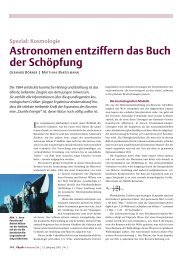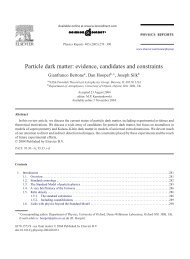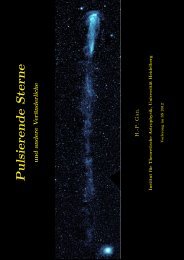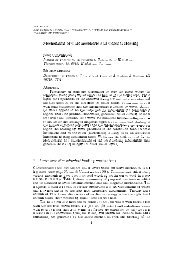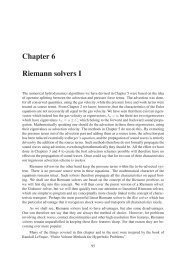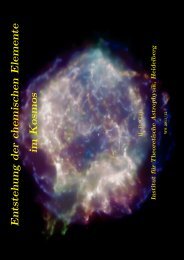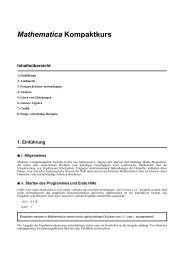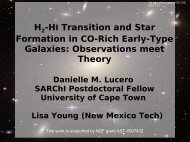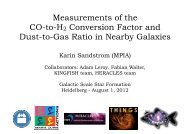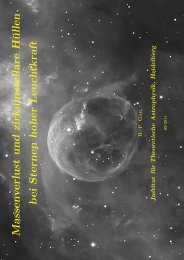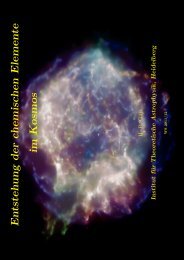low-z analogs for high-z star forming galaxies
low-z analogs for high-z star forming galaxies
low-z analogs for high-z star forming galaxies
Create successful ePaper yourself
Turn your PDF publications into a flip-book with our unique Google optimized e-Paper software.
Far-infrared line spectroscopy as a probe of<br />
<strong>star</strong> <strong>for</strong>ming regions in disks, or LIRGs, or disky LIRGs -<br />
and the nature of <strong>high</strong>-z <strong>star</strong> <strong>for</strong>ming <strong>galaxies</strong><br />
Benjamin Weiner<br />
Steward Observatory<br />
with Almudena Alonso-Herrero<br />
Wiphu Rujopakarn<br />
George Rieke<br />
Eiichi Egami
In the local universe, IR luminosity is tied to galaxy properties<br />
such as SED shape and merger stage. How will this change<br />
when we try to understand galaxy evolution across redshift?<br />
What can we use as local <strong>analogs</strong> <strong>for</strong> <strong>high</strong>-z <strong>galaxies</strong>?<br />
Is a distant LIRG or ULIRG (L>10^11, 10^12 Lsun) similar<br />
to a local LIRG or ULIRG?<br />
Far-IR line emission is a probe of galactic <strong>star</strong> <strong>for</strong>mation:<br />
use it to address these questions, with Herschel and<br />
sub-mm telescopes.
Context: High SFR in all blue <strong>galaxies</strong> at z=1: not just in mergers<br />
(from Kai Noeske, BJW et al 2007; also X. Zheng et al 2007)<br />
At z=1, the global SFR is 10x <strong>high</strong>er than today – in what <strong>galaxies</strong> does this occur?<br />
DEEP2 sample, using SFR from both far-IR (Spitzer/MIPS) and nebular emission lines.<br />
The scatter in the SFR-stellar mass relation is ~0.3 dex:<br />
“main sequence,” implies that extreme bursts are rare.<br />
The overall SFR declines gradually <strong>for</strong> the entire sample:<br />
implies that the global decline of SFR is due to a decline in all SF <strong>galaxies</strong>.<br />
Locally, LIRGs are unusual and LIRG/ULIRGs are typically major mergers,<br />
but at z=1, most <strong>star</strong> <strong>for</strong>ming <strong>galaxies</strong> at M*>1e10 are LIRGs, SFR > 10 Msun/yr.<br />
Local IR-luminous <strong>galaxies</strong> may not be good predictor of <strong>high</strong>-z properties.
Example bright LIRGs in the Groth Strip: MIPS 24um, HST/ACS I<br />
At z=1, IR-luminous <strong>galaxies</strong> more common; some LIRGs are spirals
A few ULIRGs in the Groth Strip: MIPS 24um, HST/ACS I<br />
At z=1, ULIRGs mostly look peculiar/merger, but <strong>high</strong>ly extincted
Are there two “modes” or density regimes of SF - mergers and disks?<br />
Related to spatial extent of <strong>star</strong> <strong>for</strong>mation?<br />
(Tacconi et al 2010; Genzel et al 2010)<br />
Mergers and ULIRGs are at <strong>high</strong>er L(FIR)/L(CO), while <strong>high</strong>-z <strong>star</strong> <strong>for</strong>ming <strong>galaxies</strong><br />
are at similar value of SF efficiency to <strong>low</strong>-z SFGs.<br />
Limited size in<strong>for</strong>mation suggests <strong>high</strong>-z SFGs are on a Kennicutt-Schmidt relation.<br />
Existence of separate relations is controversial.<br />
Note that <strong>high</strong>-z SFGs can have modest SF efficiency, at an L_IR that is very <strong>high</strong> in<br />
<strong>low</strong>-redshift terms.
Evolution in properties of IR-luminous <strong>galaxies</strong>: surface density?<br />
_IR<br />
L_IR<br />
Rex et al 2010:<br />
SED shapes of IR <strong>galaxies</strong> at z=1-2<br />
match the shapes of <strong>low</strong>er-luminosity<br />
local <strong>galaxies</strong>: luminosity to SED relation<br />
is shifted. Causes overestimates of<br />
L_IR from observed flux at z>1.<br />
(also Papovich+ 2007; Rigby+ 2007;<br />
Elbaz+ 2011; Nordon+ 2011)<br />
Rujopakarn et al 2010:<br />
<strong>high</strong>-z very IR-luminous <strong>galaxies</strong> have larger<br />
<strong>star</strong>-<strong>for</strong>ming radius (in radio or CO) than<br />
do local ULIRGs, so there is a difference in<br />
L_IR surface density. May explain evolution<br />
in IR spectral shapes. Could be related to<br />
SF efficiency. But, these sizes are difficult to<br />
measure.
A sample of disky U/LIRGs at <strong>low</strong> redshift<br />
Low-redshift ULIRGs and bright LIRGs (L_IR > 3e11 Lsun) are almost always mergers.<br />
But not always! We selected a sample from IRAS + SDSS at L_IR = 3e11 - 1e12 L_sun that are<br />
large radius, disky non-mergers, non-AGN. These are z ~ 0.1 and bright, so Herschel/PACS<br />
spectra are possible.<br />
Even after a large-optical-diameter selection, these <strong>galaxies</strong> were only about 5% of the ULIRG/<br />
bright LIRG population in IRAS + SDSS.<br />
They are big disk <strong>galaxies</strong>, with strong nebular lines (H, [O III], H) and likely <strong>high</strong> gas mass.<br />
Far-IR spectra probe physical conditions in <strong>star</strong> <strong>for</strong>ming regions, and can test whether these are<br />
<strong>analogs</strong> of <strong>high</strong>-z <strong>star</strong> <strong>for</strong>ming <strong>galaxies</strong> with <strong>high</strong> gas mass and L_IR.
Molecular cloud cartoon<br />
Shielded<br />
H2, CO<br />
Can emit [C II]<br />
cooling radiation<br />
H2, C+<br />
H I, H II, C+<br />
[C II] 158 µm is a dominant cooling line in PDRs, can come from neutral, ionized gas.<br />
[O I] 63 µm also a strong cooling line, can be emitted from denser parts of clouds.<br />
Extremely strong far-IR lines, ~1/300 of entire far-IR luminosity L(8-1000 µm).<br />
Line ratios are sensitive to density and ionization parameter in PDRs.<br />
C ionization potential 11.3 eV, [C II] 158 : nominal n_crit ~ 4e3 cm^-3<br />
O ionization potential 13.6 eV, [O I] 63 : n_crit ~ 6e5
The “[C II] deficit”<br />
L_[C II]/L_FIR<br />
ULIRGs<br />
(from Stacey+ 2010)<br />
Malhotra+ 2001, Luhman+ 2003: ISO spectra of [C II] 158 µm in SF <strong>galaxies</strong> and ULIRGs<br />
show that [C II]/FIR declines s<strong>low</strong>ly with L_FIR, but is very <strong>low</strong> in ULIRGs, the [C II] deficit.<br />
May be caused by <strong>high</strong>er ionization parameter and density in the ULIRGs; and/or FIR emission<br />
from non-PDR regions.<br />
Linear scaling relations do not mean a ULIRG is simply a bigger <strong>star</strong>-<strong>for</strong>ming galaxy or molecular<br />
cloud.
The “[C II] deficit” - <strong>high</strong>-z counterexamples<br />
L_[C II]/L_FIR<br />
(from Stacey+ 2010)<br />
Stacey et al 2010: Recent measurements of [C II] in z=1-2 extremely IR-luminous <strong>galaxies</strong><br />
(mostly sub-mm from ZEUS at CSO) often do not show the <strong>low</strong> [C II]/FIR seen in the local<br />
universe. Especially so <strong>for</strong> <strong>star</strong> <strong>for</strong>mation dominated <strong>galaxies</strong>. Sign of different physical<br />
conditions compared to local ULIRGs? Perhaps larger <strong>star</strong> <strong>for</strong>ming area?<br />
But these are extreme objects, and getting far-IR line spectra of z>1 LIRG/ULIRGs is very<br />
difficult even <strong>for</strong> Herschel.
Herschel/PACS spectra of [C II] in <strong>low</strong>-z <strong>galaxies</strong> from SHINING key project:<br />
[C II] deficit at <strong>high</strong> L_IR still seen, exists in other far-IR lines as well.<br />
May get <strong>low</strong>er scatter by plotting against L_IR / M(H2) -<br />
if both ratios are related to density this is sensible.<br />
Gracia-Carpio+ 2011
Our PACS disky U/LIRG sample: strong [C II] emission, little deficit<br />
ISO:<br />
Malhotra+ 2001<br />
Luhman+ 2003<br />
CSO <strong>high</strong>-z:<br />
Stacey+ 2010<br />
PACS disky<br />
U/LIRGs<br />
High [C II] / L_FIR in the disky <strong>galaxies</strong> suggests that surface density is a controlling<br />
factor, distinguishing them from <strong>low</strong>-z ULIRGs, more like <strong>high</strong>-z <strong>galaxies</strong>.<br />
In fact, the <strong>low</strong>est [C II] among our disks are also the smallest in H diameter.
SF disks and ULIRGs are also offset in [O I] / [C II], possibly a density effect<br />
log [O I] / [C II]<br />
log L_FIR
[O I] / [C II] ratio (density or ionization) is correlated with f_60 / f_100 (dust temperature)<br />
Correlation known from ISO data (Malhotra et al 2001). The disky LIRGs are cooler than<br />
ULIRGs, and shifted to <strong>low</strong>er [O I] or warmer dust compared to the <strong>low</strong>er-luminosity SFGs.
Line ratios and line/FIR can constrain density and ionization parameter in SF regions<br />
([O I] + [C II]) / FIR<br />
ionization<br />
L_FIR<br />
density<br />
From PDR Toolbox (Kaufman, Wolfire)
Summary: disky U/LIRGs at <strong>low</strong> redshift<br />
Local ULIRGs are smaller extent than <strong>high</strong>-z extreme <strong>star</strong><strong>for</strong>mers and not perfect <strong>analogs</strong>.<br />
Large, <strong>high</strong> SFR disks are rare at <strong>low</strong> redshift, but they do exist.<br />
Herschel/PACS spectra of [C II] and [O I]: disks have <strong>high</strong> [C II] / L_FIR, no [C II] deficit.<br />
Thus unlike local ULIRGs, but similar to <strong>high</strong>-z SF <strong>galaxies</strong> and extreme objects.<br />
The far-IR line ratios are plausibly explained by density effects: the disky objects have <strong>low</strong>er<br />
density or ionization, and <strong>low</strong>er dust temperature, than the ULIRGs.<br />
These objects may be a good laboratory to understand physical conditions that are<br />
more common in main-sequence or even merger SF <strong>galaxies</strong> at <strong>high</strong>er redshift. We have<br />
optical spectra <strong>for</strong> resolved metallicity and extinction, and need CO measurements <strong>for</strong><br />
surface density and SF efficiency; <strong>high</strong> resolution imaging to study distribution of SF regions.



